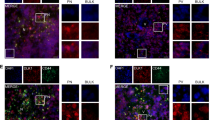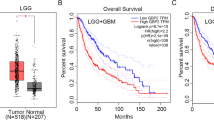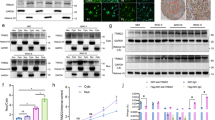Abstract
Earlier, we showed that epidermal growth factor receptor (EGFR) signaling in human glioma cells increased cyclooxygenase-2 (COX-2) expression through p38-mitogen-activated protein kinase (MAPK)-dependent activation of the Sp family of transcription factors. Further mechanistic details of EGFR-dependent induction of COX-2 expression in glioma cells remained elusive. Protein kinase Cs (PKCs) comprise a family of serine-threonine kinases that are major mediators of signaling from receptor tyrosine kinases. Here, we report that PKC-δ, a novel PKC isoform, plays a role in EGF-dependent COX-2 induction in human glioma cells. Pharmacological inhibition and genetic silencing (through siRNA or dominant-negative expression) of PKC-δ confirm a role for this PKC isoform in EGF-dependent COX-2 induction. Overexpression of a functional PKC-δ enhanced COX-2 expression indicating that PKC-δ is not only necessary but also sufficient to regulate COX-2 levels. Inhibition of p38-MAPK pharmacologically or with siRNA further shows that p38-MAPK is required for activation of PKC-δ by EGF while inhibition of PKC-δ had no discernible effects on p38-MAPK activation. Finally, EGF stimulation promotes physical interactions between PKC-δ and Sp1 resulting in phosphorylation and nuclear localization of this transcription factor. These data provide the first evidence that PKC-δ is a critical link between p38-MAPK and Sp1-dependent COX-2 expression in human glioma cells.
This is a preview of subscription content, access via your institution
Access options
Subscribe to this journal
Receive 50 print issues and online access
$259.00 per year
only $5.18 per issue
Buy this article
- Purchase on Springer Link
- Instant access to full article PDF
Prices may be subject to local taxes which are calculated during checkout







Similar content being viewed by others
References
Abbott KL, Loss II JR, Robida AM, Murphy TJ . (2000). Evidence that Galpha(q)-coupled receptor-induced interleukin-6 mRNA in vascular smooth muscle cells involves the nuclear factor of activated T cells. Mol Pharmacol 58: 946–953.
Awasthi V, King RJ . (2000). PKC, p42/p44 MAPK, and p38 MAPK are required for HGF-induced proliferation of H441 cells. Am J Physiol Lung Cell Mol Physiol 279: L942–L949.
Baltuch GH, Yong VW . (1996). Signal transduction for proliferation of glioma cells in vitro occurs predominantly through a protein kinase C-mediated pathway. Brain Res 710: 143–149.
Bijnsdorp IV, van den Berg J, Kuipers GK, Wedekind LE, Slotman BJ, van Rijn J et al. (2007). Radiosensitizing potential of the selective cyclooygenase-2 (COX-2) inhibitor meloxicam on human glioma cells. J Neurooncol 85: 25–31.
Bornancin F, Parker PJ . (1997). Phosphorylation of protein kinase C-alpha on serine 657 controls the accumulation of active enzyme and contributes to its phosphatase-resistant state. J Biol Chem 272: 3544–3549.
Bredel M, Pollack IF . (1997). The role of protein kinase C (PKC) in the evolution and proliferation of malignant gliomas, and the application of PKC inhibition as a novel approach to anti-glioma therapy. Acta Neurochir (Wien) 139: 1000–1013.
Buccoliero AM, Caldarella A, Gheri CF, Taddei A, Paglierani M, Pepi M et al. (2006). Inducible cyclooxygenase (COX-2) in glioblastoma—clinical and immunohistochemical (COX-2-VEGF) correlations. Clin Neuropathol 25: 59–66.
Chupreta S, Du M, Todisco A, Merchant JL . (2000). EGF stimulates gastrin promoter through activation of Sp1 kinase activity. Am J Physiol Cell Physiol 278: C697–C708.
Couldwell WT, Antel JP, Apuzzo ML, Yong VW . (1990). Inhibition of growth of established human glioma cell lines by modulators of the protein kinase-C system. J Neurosurg 73: 594–600.
Couldwell WT, Uhm JH, Antel JP, Yong VW . (1991). Enhanced protein kinase C activity correlates with the growth rate of malignant gliomas in vitro. Neurosurgery 29: 880–886; discussion 886–7.
D’Addario M, Arora PD, Ellen RP, McCulloch CA . (2002). Interaction of p38 and Sp1 in a mechanical force-induced, beta 1 integrin-mediated transcriptional circuit that regulates the actin-binding protein filamin-A. J Biol Chem 277: 47541–47550.
D’Addario M, Arora PD, McCulloch CA . (2006). Role of p38 in stress activation of Sp1. Gene 379: 51–61.
Doller A, Huwiler A, Muller R, Radeke HH, Pfeilschifter J, Eberhardt W . (2007). Protein kinase C alpha-dependent phosphorylation of the mRNA-stabilizing factor HuR: implications for posttranscriptional regulation of cyclooxygenase-2. Mol Biol Cell 18: 2137–2148.
Guan Z, Buckman SY, Miller BW, Springer LD, Morrison AR . (1998). Interleukin-1beta-induced cyclooxygenase-2 expression requires activation of both c-Jun NH2-terminal kinase and p38 MAPK signal pathways in rat renal mesangial cells. J Biol Chem 273: 28670–28676.
Hofmann J . (2004). Protein kinase C isozymes as potential targets for anticancer therapy. Curr Cancer Drug Targets 4: 125–146.
Hsieh HL, Wang HH, Wu CY, Jou MJ, Yen MH, Parker P et al. (2007). BK-induced COX-2 expression via PKC-delta-dependent activation of p42/p44 MAPK and NF-kappaB in astrocytes. Cell Signal 19: 330–340.
Humphrey PA, Gangarosa LM, Wong AJ, Archer GE, Lund-Johansen M, Bjerkvig R et al. (1991). Deletion-mutant epidermal growth factor receptor in human gliomas: effects of type II mutation on receptor function. Biochem Biophys Res Commun 178: 1413–1420.
Iwabu A, Smith K, Allen FD, Lauffenburger DA, Wells A . (2004). Epidermal growth factor induces fibroblast contractility and motility via a protein kinase C delta-dependent pathway. J Biol Chem 279: 14551–14560.
Joki T, Heese O, Nikas DC, Bello L, Zhang J, Kraeft SK et al. (2000). Expression of cyclooxygenase 2 (COX-2) in human glioma and in vitro inhibition by a specific COX-2 inhibitor, NS-398. Cancer Res 60: 4926–4931.
Kang KB, Wang TT, Woon CT, Cheah ES, Moore XL, Zhu C et al. (2007). Enhancement of glioblastoma radioresponse by a selective COX-2 inhibitor celecoxib: inhibition of tumor angiogenesis with extensive tumor necrosis. Int J Radiat Oncol Biol Phys 67: 888–896.
Karim A, McCarthy K, Jawahar A, Smith D, Willis B, Nanda A . (2005). Differential cyclooxygenase-2 enzyme expression in radiosensitive versus radioresistant glioblastoma multiforme cell lines. Anticancer Res 25: 675–679.
Kuwahara J, Watanabe Y, Kayasuga T, Itoh K . (2000). Zn finger and nuclear localization of transcription factor Sp1. Nucleic Acids Symp Ser 44: 265–266.
Lee J, Kosaras B, Aleyasin H, Han JA, Park DS, Ratan RR et al. (2006a). Role of cyclooxygenase-2 induction by transcription factor Sp1 and Sp3 in neuronal oxidative and DNA damage response. FASEB J 20: 2375–2377.
Lee MY, Park SH, Lee YJ, Heo JS, Lee JH, Han HJ . (2006b). EGF-induced inhibition of glucose transport is mediated by PKC and MAPK signal pathways in primary cultured chicken hepatocytes. Am J Physiol Gastrointest Liver Physiol 291: G744–G750.
Li B, Yuan M, Kim IA, Chang CM, Bernhard EJ, Shu HK . (2004). Mutant epidermal growth factor receptor displays increased signaling through the phosphatidylinositol-3 kinase/AKT pathway and promotes radioresistance in cells of astrocytic origin. Oncogene 23: 4594–4602.
Libermann TA, Nusbaum HR, Razon N, Kris R, Lax I, Soreq H et al. (1985). Amplification, enhanced expression and possible rearrangement of EGF receptor gene in primary human brain tumours of glial origin. Nature 313: 144–147.
Machide M, Kamitori K, Nakamura Y, Kohsaka S . (1998). Selective activation of phospholipase C gamma1 and distinct protein kinase C subspecies in intracellular signaling by hepatocyte growth factor/scatter factor in primary cultured rat neocortical cells. J Neurochem 71: 592–602.
Martelli AM, Faenza I, Billi AM, Fala F, Cocco L, Manzoli L . (2003). Nuclear protein kinase C isoforms: key players in multiple cell functions? Histol Histopathol 18: 1301–1312.
Merchant JL, Du M, Todisco A . (1999). Sp1 phosphorylation by Erk 2 stimulates DNA binding. Biochem Biophys Res Commun 254: 454–461.
Mimura Y, Ihn H, Jinnin M, Asano Y, Yamane K, Tamaki K . (2004). Epidermal growth factor induces fibronectin expression in human dermal fibroblasts via protein kinase C delta signaling pathway. J Invest Dermatol 122: 1390–1398.
Moriya M, Tanaka S . (1994). Prominent expression of protein kinase C (gamma) mRNA in the dendrite-rich neuropil of mice cerebellum at the critical period for synaptogenesis. Neuroreport 5: 929–932.
Murphy TJ, Pavlath GK, Wang X, Boss V, Abbott KL, Robida AM et al. (2002). Retroviral vectors applied to gene regulation studies. Methods Enzymol 345: 539–551.
Musashi M, Ota S, Shiroshita N . (2000). The role of protein kinase C isoforms in cell proliferation and apoptosis. Int J Hematol 72: 12–19.
Newton AC . (1997). Regulation of protein kinase C. Curr Opin Cell Biol 9: 161–167.
Nishizuka Y . (1995). Protein kinase C and lipid signaling for sustained cellular responses. FASEB J 9: 484–496.
Pal S, Claffey KP, Cohen HT, Mukhopadhyay D . (1998). Activation of Sp1-mediated vascular permeability factor/vascular endothelial growth factor transcription requires specific interaction with protein kinase C zeta. J Biol Chem 273: 26277–26280.
Pang L, Nie M, Corbett L, Donnelly R, Gray S, Knox AJ . (2002). Protein kinase C-epsilon mediates bradykinin-induced cyclooxygenase-2 expression in human airway smooth muscle cells. FASEB J 16: 1435–1437.
Park YS, Kim J, Misonou Y, Takamiya R, Takahashi M, Freeman MR et al. (2007). Acrolein induces cyclooxygenase-2 and prostaglandin production in human umbilical vein endothelial cells: roles of p38 MAP kinase. Arterioscler Thromb Vasc Biol 27: 1319–1325.
Pollack IF, Randall MS, Kristofik MP, Kelly RH, Selker RG, Vertosick Jr FT . (1990). Response of malignant glioma cell lines to activation and inhibition of protein kinase C-mediated pathways. J Neurosurg 73: 98–105.
Prayson RA, Castilla EA, Vogelbaum MA, Barnett GH . (2002). Cyclooxygenase-2 (COX-2) expression by immunohistochemistry in glioblastoma multiforme. Ann Diagn Pathol 6: 148–153.
Rafty LA, Khachigian LM . (2001). Sp1 phosphorylation regulates inducible expression of platelet-derived growth factor B-chain gene via atypical protein kinase C-zeta. Nucleic Acids Res 29: 1027–1033.
Reisinger K, Kaufmann R, Gille J . (2003). Increased Sp1 phosphorylation as a mechanism of hepatocyte growth factor (HGF/SF)-induced vascular endothelial growth factor (VEGF/VPF) transcription. J Cell Sci 116: 225–238.
Rojo AI, Salina M, Salazar M, Takahashi S, Suske G, Calvo V et al. (2006). Regulation of heme oxygenase-1 gene expression through the phosphatidylinositol 3-kinase/PKC-zeta pathway and Sp1. Free Radic Biol Med 41: 247–261.
Rosell R, Taron M, Reguart N, Isla D, Moran T . (2006). Epidermal growth factor receptor activation: how exon 19 and 21 mutations changed our understanding of the pathway. Clin Cancer Res 12: 7222–7231.
Shono T, Tofilon PJ, Bruner JM, Owolabi O, Lang FF . (2001). Cyclooxygenase-2 expression in human gliomas: prognostic significance and molecular correlations. Cancer Res 61: 4375–4381.
Sminia P, Stoter TR, van der Valk P, Elkhuizen PH, Tadema TM, Kuipers GK et al. (2005). Expression of cyclooxygenase-2 and epidermal growth factor receptor in primary and recurrent glioblastoma multiforme. J Cancer Res Clin Oncol 131: 653–661.
Soh JW, Lee EH, Prywes R, Weinstein IB . (1999). Novel roles of specific isoforms of protein kinase C in activation of the c-fos serum response element. Mol Cell Biol 19: 1313–1324.
Subbaramaiah K, Chung WJ, Dannenberg AJ . (1998). Ceramide regulates the transcription of cyclooxygenase-2. Evidence for involvement of extracellular signal-regulated kinase/c-Jun N-terminal kinase and p38 mitogen-activated protein kinase pathways. J Biol Chem 273: 32943–32949.
Wang HQ, Kim MP, Tiano HF, Langenbach R, Smart RC . (2001). Protein kinase C-alpha coordinately regulates cytosolic phospholipase A(2) activity and the expression of cyclooxygenase-2 through different mechanisms in mouse keratinocytes. Mol Pharmacol 59: 860–866.
Xu K, Murphy TJ . (2000). Reconstitution of angiotensin receptor mRNA down-regulation in vascular smooth muscle. Post-transcriptional control by protein kinase a but not mitogenic signaling directed by the 5′-untranslated region. J Biol Chem 275: 7604–7611.
Xu K, Shu HK . (2007). EGFR activation results in enhanced cyclooxygenase-2 expression through p38 mitogen-activated protein kinase-dependent activation of the Sp1/Sp3 transcription factors in human gliomas. Cancer Res 67: 6121–6129.
Xu Q, Ji YS, Schmedtje Jr JF . (2000). Sp1 increases expression of cyclooxygenase-2 in hypoxic vascular endothelium. Implications for the mechanisms of aortic aneurysm and heart failure. J Biol Chem 275: 24583–24589.
Yu W, Murray NR, Weems C, Chen L, Guo H, Ethridge R et al. (2003). Role of cyclooxygenase 2 in protein kinase C beta II-mediated colon carcinogenesis. J Biol Chem 278: 11167–11174.
Zheng XL, Matsubara S, Diao C, Hollenberg MD, Wong NC . (2001). Epidermal growth factor induction of apolipoprotein A-I is mediated by the Ras-MAP kinase cascade and Sp1. J Biol Chem 276: 13822–13829.
Acknowledgements
This study was supported, in part, by a grant to H-K Shu from the Childhood Brain Tumor Foundation. We thank Dr Jiahuai Han for providing mammalian expression plasmids-containing MKK3 and MKK6 and Dr Jae-Won Soh for providing mammalian expression plasmids-containing PKC-δ variants.
Author information
Authors and Affiliations
Corresponding author
Rights and permissions
About this article
Cite this article
Xu, K., Chang, CM., Gao, H. et al. Epidermal growth factor-dependent cyclooxygenase-2 induction in gliomas requires protein kinase C-δ. Oncogene 28, 1410–1420 (2009). https://doi.org/10.1038/onc.2008.500
Received:
Revised:
Accepted:
Published:
Issue Date:
DOI: https://doi.org/10.1038/onc.2008.500
Keywords
This article is cited by
-
Hesperidin alleviates rat postoperative ileus through anti-inflammation and stimulation of Ca2+-dependent myosin phosphorylation
Acta Pharmacologica Sinica (2016)
-
Targeting PKCδ-mediated topoisomerase IIβ overexpression subverts the differentiation block in a retinoic acid-resistant APL cell line
Leukemia (2010)



